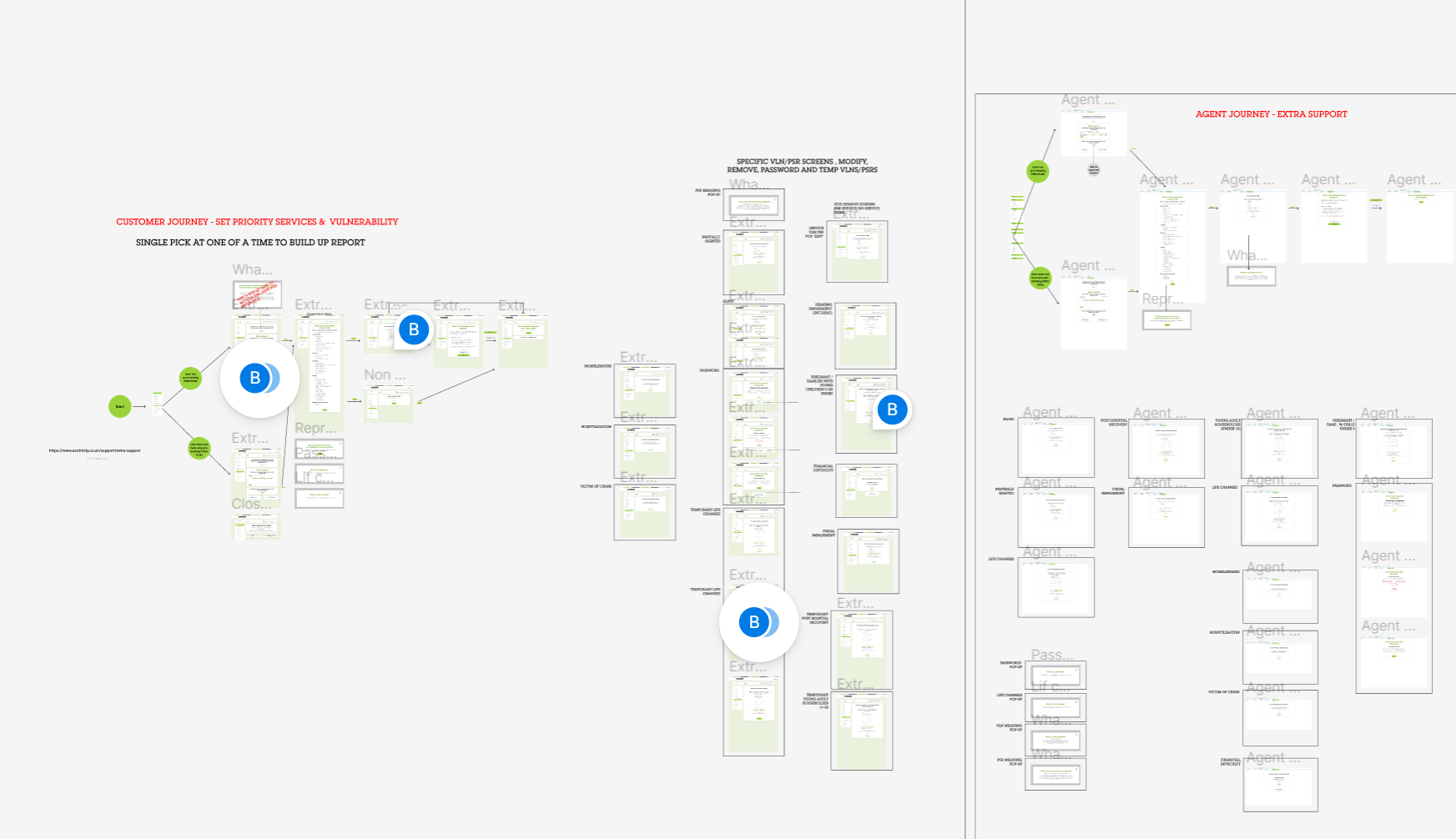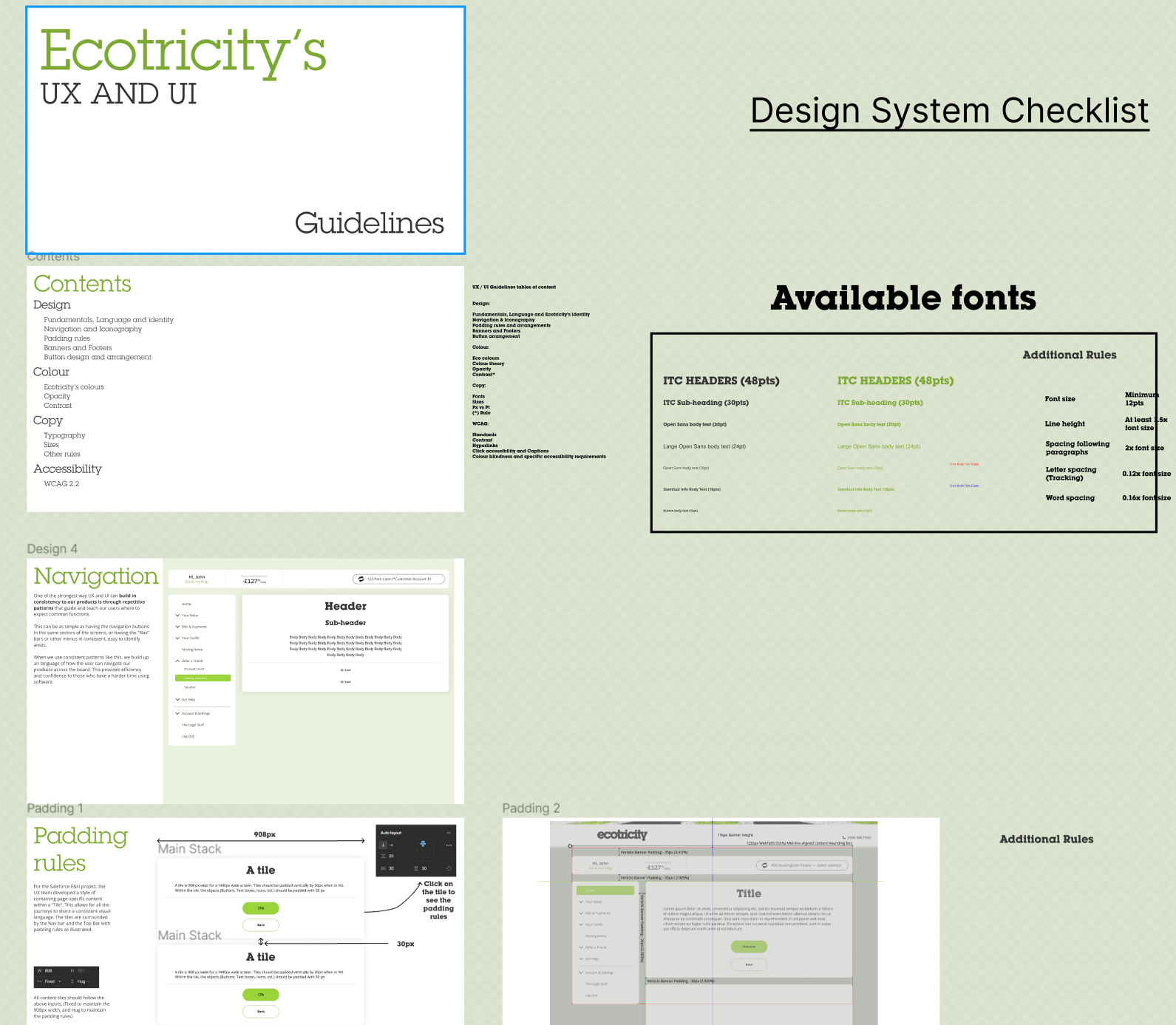Ecotricity: A study of Self-Serve
Ecotricity: A study of Self-Serve
Ecotricity Hired Beau to quickly onboard and develop their User stories through to the Deployment of their biggest Digital experience overhaul, end to end. Ecotricity developed their first self-serve portal on the Salesforce platform.
The Problem
Ecotricity previously operated largely on Phonelines and scattered use of online web flow to interface with its customers for business requests and vital actions for the delivery of the service, a customer sending their Electric meter read. Therefore the B2C Growth plan designed a move to a unified service platform through Salesforce that would facilitate the interactions between customers and Eco, and improve business function and customer experience.
The Major directive was to create an online Self-Serve portal that would both improve the Customer experience of day-to-day interactions, as well as provide a competitive experience in comparison to other Industry leaders.
The Primary Goal
The primary goal is to create a self-serve portal that will promote an End user’s behavioral change in the interactions between Ecotricity’s service and the User experience. Specifically, this was to push end users to complete tasks like submitting a Meter Read, Upgrading to a Smart Meter, or applying for PSR accessibility services without the need to call into Ecotricity’s phone lines. In turn, this would reduce the Cost-to-serve per customer and improve Agent response times by reducing the customer-to-agent ratio.
The Secondary Goal
Ensuring that business requirements were understood, communicated clearly, and developed from User stories to end product via an external developer.
Conducting collaborative workshop sessions within an Agile working environment to pass from Low-fi to High-fi at pace, delivering to our external developers.
Conducting SUS UAT both internally and externally to report on the impact of the project.
Stakeholders and End users
B2C personas were used throughout low-fi and process mapping to link our online offerings to our customers’ needs. Below are some shortened snippets of the full Ecotricity domestic personas.
Excluded from below, we included their level of awareness about climate change, reasons why they would switch, preferred media touchpoints, and stats or details such as age, location, interests, and alignments.
Fiona - Rural Organics
“I think it’s really easy to be green”
Fiona lives in Kemble in the Cotswolds. She regularly donates to the RSPB and the RSPCA, and will volunteer her time at her local WWT. She spends her leisure time either in the garden or out walking with her friends or husband. She enjoys frequent travel abroad on self-catering family holidays or on a cruise with her husband. She also spends quite a bit of time on the internet searching for garden products, cars or reading news articles. She likes nothing more than to get a good deal on eBay too!
William - Middle aged affluent professional
“What else can I do to be green?”
William likes sports including cricket and football, and long walks with the dogs and his family. He enjoys eating out or cooking exotic cuisines at home, reading or listening to books or online blogs and BBC podcasts and music. He’s quite busy with work, so spends a lot of time in the evenings on the laptop – so will catch up with the news, current affairs and financial investments online. Being environmentally conscious is a family affair, with research and regular discussions about what they can do as a family to reduce their impact on the planet.
Ben - Efficient, family-centric nature explorer
“Going green for my grandkid’s future”
Ben lives in a small town in Surrey. He regularly reads and donates to the RSPB and receives weekly Riverford boxes. Being recently retired means that he centres his free time around his grandchildren, gardening and cooking fresh, healthy meals. As his children are avid vegans, he’s working towards adopting a more flexitarian diet but enjoys a steak from time to time. Being an active member of his local community is very important to Ben.
Izzy - Fun loving young
“Have you tried that new plant-based café in town?”
Izzy loves music, festivals, films and fun times. She’s highly sociable and lives in North London, pursuing a lifestyle of novelty and change. She is out with friends, eating or drinking most nights. If not, then she’s planning her next big trip abroad, buying gig tickets or streaming music. She’s led by the heart, and is really engaged with us because we’re modern and edgy and we make her feel part of the team. She does everything online, from managing her finances, accessing news and current affairs to buying clothes and groceries.
Sam - Green hearted, money poor
“What else can I do to be green, that I can afford?”
Sam is a relaxed family mum, and loves spending time with her family and exploring new places with her kids. She’ll pack up the camper van on the weekend and head off down south to enjoy the great outdoors. She’s also a music lover, and goes to family festivals and watches local bands when he can. She’s with Bulb, but was with us. She’ll always choose green energy but price is the deciding factor for which supplier she chooses. She sees us as a progressive, innovative & ecological company and she’d love to be a customer again as she was really happy with our friendly customer service - but just can’t afford it.
Emily- Ambitious career and property climber
“By using green energy we can tackle climate change”
Emily is a young ambitious professional, and is led by her brain more than her heart. She enjoys visiting art galleries and the theatre, or the cinema and eating out – but she expects that to be more difficult when they move home as they won’t have as much disposable income. She goes to the gym at least 3 times a week and likes running. She’s online quite a lot and follows her favourite brands and celebs, she also spends time on social media – uploading content and sharing updates. She also has a health and fitness blog, so will often choose vegetarian food as the healthiest choice. She’s always got the latest smartphone or tech and has an app for everything!
Design and Development
Design Process
Working within an Agile workflow with both our internal stakeholders and external developers called for iterative sprints focused on feedback and iteration. With the use of Figma, collaboration workshops, and User stories we ensured we communicated our designs to our developers while maintaining the limitations of the Salesforce platform.
Implementing user feedback
User feedback was used in both the iterative design cycles and periodically to establish an understanding of actual effectiveness. These sessions were design workshops in which we would rapidly prototype with stakeholders to translate User stories to low-fis or to test the user journeys through UAT (User Acceptance Testing) with SUS scoring (System Usability Scoring) to rapidly gather feedback before further iteration.
UAT testing with customers
Challenges within design
Compliant Language
Introducing new, Ofgem-regulated, technical language to the customer base was a problem that was picked up in design workshops. Ofgem aims to unify language around customers’ rights, to allow for greater general understanding. However, this led to a problem with the introduction of new language that the user may not be familiar with.
One example of this is the "Extra Support" user journey, which covers Priority Service Requirements (PSRs) and Vulnerabilities (VLNs) for end users. The technical language and similarities between PSRs and VLNs created confusion for users.
To address this, we grouped PSRs and VLNs under the term "Extra Support" and added optional information to the web flow, allowing users to report a PSR or VLN based on their consent to share details. This streamlined the user experience and eliminated confusion.
We supplemented this streamlined approach with optional information with the tone of voice to inform the user in a clear and compliant approach. We also stressed the difference between the two by illustrating the difference in privacy, depth of service, and safety. This ensures that users can confidently follow a user flow that deals with a single piece of information at a time.
Diverging design language
At the design stage, there was a contractor for Eco, Eco’s UX team, and an external developer. This meant that there were three separate design languages creating the user flow, as I joined the design group after some of the major user journeys were wireframed, I could see the impact the divergence had on user navigation and accessibility. On top of this, initially, there was a blend of the Salesforce platform and Ecotricity branding.
From this, I worked with the Head of Design to develop Ecotricity’s first digital branding guidelines which began to develop an institutional understanding of Eco’s UI and UX patterns. Then we audited the previous wireframe for redesign to both promote Ecotricty’s brand, and brand cohesion and typical navigation patterns and CTAs.
This was an important piece of work due to the range of digital proficiency in end users and provided a position to introduce good practices for design for accessibility.
The impact of this was illustrated in user testing with end users, SUS scores were very positive and users found navigating the user journeys easy and intuitive.






In Review
My Takeaways
Designing a self-serve portal is a balance between representing internal stakeholders to designing a product that’s effective and reduces the workload of internal processes as a first priority, but cannot sacrifice the user’s experience at any point.
Major learnings within this project were in how to convert business terminology and processes into an experience that the user feels fully in control of. Elements such as the industry language, abiding by regulations, and other important business considerations don’t directly support good communication between what is being asked of customers, so creating user-focused solutions to this was critical to both the ease of use and ease of understanding of the user to provide greater confidence.
This project also highlighted the importance of early and continuous user feedback from a realistic external pool of end-users/customers. The UAT and other testing highlighted these problem areas that were ‘assumed’ to be fit for purpose prior, a wake-up call to design teams that assume they know their customer base.
Moving forwards
Moving forwards, Eco’s UX team will prioritise gathering user feedback more frequently throughout the design and development of a digital experience, but more importantly, the UX team will illustrate the powerful insights that can be gathered and the wealth of understanding that can positively form an interactive design into a robust holistic service. Through developing a greater understanding of the value and impact of UX techniques to internal stakeholders, Ecotricity will be better equip to develop existing Eco products as well as design for greater impact in upcoming products.



















